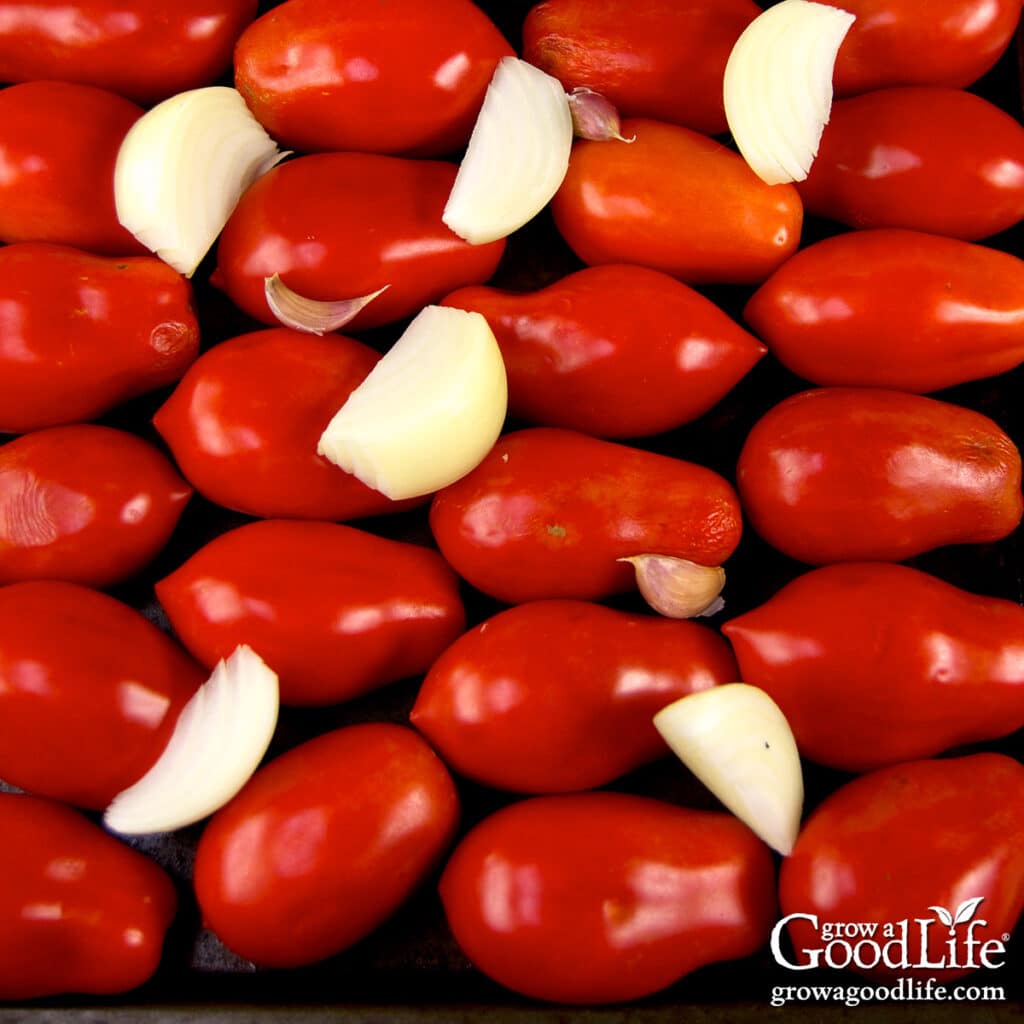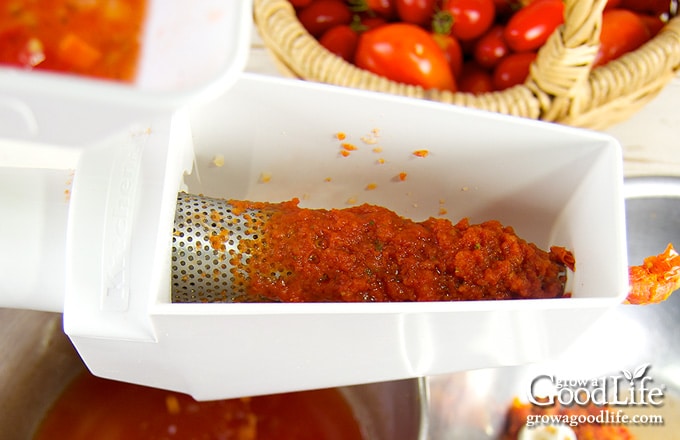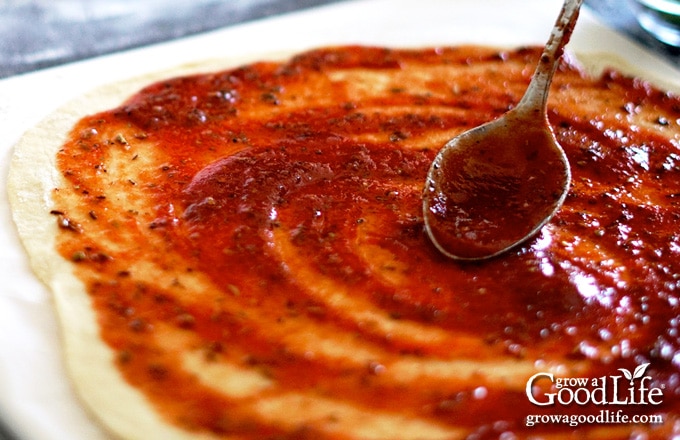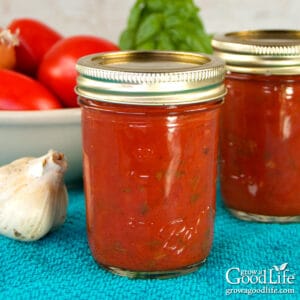Pizza Sauce Canning Recipe
This post may contain affiliate links, which means that I may receive a commission if you make a purchase using these links. As an Amazon Associate I earn from qualifying purchases.
Preserve fresh tomatoes with this pizza sauce canning recipe. Roasted tomatoes, onions, and garlic create a rich, full-flavored sauce for homemade pizza.

If you love homemade pizza night, this pizza sauce canning recipe will become a pantry staple. Roasting the tomatoes, onions, and garlic first deepens their natural sweetness and creates a rich, robust flavor. This tested home canning recipe captures that wood-fired pizza taste in a jar. Perfect for topping pizzas, spreading on calzones, or using as a base for pasta dishes.
The inspiration for this sauce came from an impromptu stop at the farmer’s market one late-summer afternoon. A vendor was clearing out crates of overripe Roma tomatoes at the end of the day, and I couldn’t pass up the deal or the opportunity to turn them into something delicious.
They were very ripe. Very, very ripe. I hesitated for a moment, wondering if I could process them all before they spoiled. Then I did what every gardener and canner does when faced with abundance: I bought them all. Before I knew it, I was hauling about 20 pounds of tomatoes to the car.
As I loaded the crates into the trunk, the air filled with that earthy, sun-warmed tomato aroma that instantly said, SAUCE. Pizza is something we enjoy at least once a week, so having jars of homemade pizza sauce ready to go would make those nights even better.

When I got home, I washed the tomatoes and spread them out to dry while deciding how to make the most of them. I reached for my trusty Ball Blue Book Guide to Preserving, flipped to the “Basil-Garlic Tomato Sauce” recipe, and decided to give it my own twist. By roasting the tomatoes, garlic, and onions first, I could coax out an even deeper, caramelized flavor. As the vegetables roasted, I gathered my canning supplies and largest saucepan, already imagining the rich, savory sauce they’d become.
Why You’ll Love This Pizza Sauce Canning Recipe
- Rich, roasted flavor: Roasting the tomatoes, onions, and garlic concentrates their natural sweetness and adds a subtle smoky depth that makes every bite taste like it came from a wood-fired oven.
- Perfect for pizza night: This sauce has the ideal balance of tomato richness and savory herbs, and is thick enough to spread on pizza crust without making it soggy.
- Simple, small-batch friendly: The recipe makes about 14 half-pints or 7 pints, easy to manage without taking up your entire day.
- Safe and tested: Adapted from the Ball Blue Book Guide to Preserving, this recipe follows tested home-canning guidelines so you can preserve your sauce with confidence.
- Versatile and delicious: Beyond pizza, use this sauce as a base for pasta, lasagna, or casseroles. It’s a go-to for quick, flavorful meals straight from your pantry.
Once you’ve tried your own homemade pizza sauce, you’ll never reach for a store-bought jar again.
Ingredients You’ll Need
- Tomatoes: You’ll need about 20 pounds of paste or plum tomatoes, such as Roma, San Marzano, or Amish Paste. These varieties are meaty and low in water, making them ideal for canning sauce. Choose firm, ripe tomatoes with no signs of rot, insect damage, or disease. Avoid tomatoes from frost-killed vines, as acidity levels may change.
- Onions: You’ll need about 1 medium onion, to yield 1 cup chopped. Yellow onions are classic, but white, red, or sweet onions can be used too. Onions add subtle sweetness and depth to the sauce.
- Garlic: Use 8 cloves of garlic, left whole for roasting. Once roasted, the garlic softens and mellows, adding a rich, earthy flavor that perfectly complements the tomatoes and basil.
- Fresh Basil: You’ll need 1/4 cup finely minced fresh basil. Basil adds a bright, fresh note that balances the deep roasted tomato flavor.
- Salt (optional): Include up to 2 teaspoons of salt for flavor, or adjust to taste. Salt is not required for safety, so you may omit it if desired.
- Citric Acid or Bottled Lemon Juice (required for safety): Acidifying the sauce ensures it remains at a safe pH for water bath canning. Citric acid is flavor-neutral, while bottled lemon juice adds a slight tang. Avoid fresh lemon juice, as its acidity varies.
Safe Adjustments
While home canning recipes are tested as safe as written, there is some flexibility to customize the flavor while staying within safe limits. Here are a few safe adjustments you can make:
- Use any tomato variety: Any tomato variety will work, though paste tomatoes make the thickest sauce. If using juicier types, simmer longer to reduce the liquid.
- Swap the fresh herbs: You may substitute other fresh herbs, such as oregano, thyme, or parsley, for the basil, as long as the total amount of fresh herbs doesn’t exceed 1/4 cup.
- Onions and garlic: You can reduce these, but do not increase the total quantity since they are low-acid ingredients. For a bolder garlic flavor, add garlic powder instead.
- Add a little sugar: If desired, you can add sugar to balance the acidity or enhance the sweetness. Up to 1 teaspoon per pint or 2 teaspoons per quart is safe and will not affect processing.
For more details on customizing tomato canning recipes safely, see: How to Safely Modify Tomato Canning Recipes.
Steps to Making and Canning Pizza Sauce
When canning, it is important to use a recipe that has been scientifically tested. This homemade pizza sauce recipe is the “Basil-Garlic Tomato Sauce” from the Ball Blue Book Guide to Preserving.
If you’re new to water bath canning, you may want to review the basics before you begin: Water Bath Canning for Beginners.
To stay organized during your canning session, I also recommend using my free Home Canning Checklist. It includes a prep checklist and space to record each batch you preserve. Get it here:

Grab your Free copy
Home Canning Checklists
A detailed and printable recipe can be found at the bottom of this article, but these are the general steps for making and preserving pizza sauce at home using a boiling water canner:
Step 1: Gather Your Kitchen and Canning Equipment
You will need:
- 3 to 4 Rimmed baking sheets
- Food strainer, food mill, or sieve
- Water bath canner with canning rack
- Canning Jars: 14 half-pint canning jars, or 7 pint sized jars
- Canning lids and bands (new lids for each jar, bands can be reused)
- Canning tools: jar lifter, canning ladle, funnel, and bubble popper
- Plus basic kitchen supplies: large saucepot, prep bowls, towels, knife, cutting board, and a large spoon.
Step 2: Prepare the Ingredients
Preheat the oven to 325°F.
Weigh and wash the tomatoes well under clean, running water, and spread them out to air dry on towels. Remove the peelings from the onion. Chop and measure 1 cup of chopped onions. Peel the garlic and keep the cloves whole.
Roast the Tomatoes, Onions, and Garlic
Place tomatoes on four shallow, rimmed baking sheets. Spread the chopped onions out on top, and add the garlic cloves.
Pop the baking sheets into the preheated oven to roast until the tomatoes burst, about 20 to 30 minutes. Rotate the pans halfway through so everything roasts evenly.

Remove the baking sheets from the oven and let the vegetables cool until they are cool enough to handle.
Purée the Vegetables
Run the roasted vegetables through a food strainer to puree and remove the tomato skins and seeds.
A tomato strainer is a great investment if you make tomato sauce from fresh tomatoes. You simply place the tomatoes in the hopper, crank it, and the skins and seeds are strained out from the juicy pulp.

If you have a Kitchen Aid mixer, there is a fruit and vegetable strainer attachment that makes quick work of separating the skins and seeds from the pulp.
If you don’t have a food strainer, let the tomatoes cool to a point where you can handle them. Then, remove the peels, cut the tomatoes in half, and remove the seeds and core. Purée the roasted vegetables in batches using a blender, food processor, or hand-held immersion blender. Learn more here: How to Peel Tomatoes.
Step 3: Make the Tomato Sauce
Add the tomato purée to a large saucepan, stir in the chopped basil and salt (if using), and bring the mixture to a gentle simmer over medium heat. Cook uncovered, stirring often to prevent sticking, until the sauce has thickened and reduced by about half.
Depending on the juiciness of your tomatoes, this may take 30 to 60 minutes or longer. Continue simmering until the sauce reaches your desired consistency.

Step 4: Prepare the Canner and Jars
When the sauce is almost finished simmering, prepare the jars, set up the canner, and organize your work area.
Wash your jars, lids, bands, and canning tools in warm, soapy water. Rinse well, and set the clean lids, bands, and tools aside to air dry until you are ready to use them.
Jars must be heated before filling to prevent breakage due to thermal shock. Place the jar rack into the water bath canner, set the jars upright in the canner, and add water to cover the jars.
Bring the canner to a simmer (180˚F) for 10 minutes, and keep the jars hot until you are ready to fill them.
Step 5: Fill the Jars with Pizza Sauce
Spread a kitchen towel on the counter, and place the canning tools and citric acid or lemon juice nearby, along with the measuring spoons.
Use the jar lifter to remove a hot jar from the canner, drain it, and place it on the towel. Keep the remaining jars in the canner, so they stay warm.
Add citric acid or lemon juice to the jar:
- Half-pint jar: Add 1/8 teaspoon citric acid or 1/2 tablespoon bottled lemon juice
- Pint jar: Add 1/4 teaspoon citric acid or 1 tablespoon bottled lemon juice
Place the canning funnel on the jar, and ladle hot sauce into the jar while filling to within 1/2 inch of the top. Run the bubble popper through the jar to release any trapped air bubbles.
Wipe the rim with a damp towel to remove residue. Center a lid on the jar, place the band over the lid, and screw it on until fingertip tight. Place the jar back into the canner, and repeat with the rest of the jars.
Step 6: Process in a Water Bath Canner
Once all jars are filled and placed back into the canner, adjust the water level so it covers the jars by at least 2 inches. Cover the canner and bring the water to a rolling boil.
Once the water boils vigorously, set a timer and process the jars in a boiling water canner for the time listed in the recipe below, adjusting for altitude if necessary.
Step 7: Cool and Store
When the processing time is complete, turn off the heat and remove the canner lid. Let the jars rest in the canner for 5 minutes to help them adjust to the temperature change.
Spread a dry towel on the counter. Then, use the jar lifter to remove the jars and place them on the towel, spacing them a few inches apart. Keep the jars upright as you lift them out of the canner and onto the towel, and don’t touch the lids or bands yet. Let them cool undisturbed for 12 to 24 hours.
After the jars have cooled for at least 12 hours, check the seals by pressing the center of each lid. If the lid does not pop up, the jar is sealed. Remove the rings and wash the jars in warm, sudsy water to remove residue. Label the jars with the date and contents, and store them in a cool, dark place. For the best flavor, use within 12 to 18 months.
Store opened jars, and any jars that failed to seal in the refrigerator, and use them within a few days.

Ways to Use Pizza Sauce
When pizza night rolls around, pop open a jar of your homemade pizza sauce and spread it over your favorite crust for a quick and flavorful meal. Add plenty of cheese, your favorite toppings, and season with black pepper, fresh basil, oregano, parsley, or a pinch of red pepper flakes for extra kick.
This rich, roasted tomato sauce is also delicious as a dipping sauce for breadsticks, calzones, or mozzarella sticks, or as a base for homemade stromboli and flatbreads.
However you use it, you’ll love the bright tomato flavor and hint of roasted garlic in every bite.


Pizza Sauce Canning Recipe
Ingredients
- 20 pounds Roma tomatoes
- 1 cup chopped onion
- 8 cloves garlic
- 1/4 cup finely minced fresh basil
- 2 teaspoons salt optional for flavor
- Citric acid or bottled lemon juice
Instructions
Make the Sauce
- Preheat the oven to 325˚F / 177˚C.
- Place the tomatoes, onions, and garlic on four shallow rimmed baking sheets and roast until the tomatoes are soft, about 20 to 30 minutes.
- Let the vegetables cool slightly, and then remove the seeds and skins using a food strainer or food mill. Be sure to include any liquid that is released from the roasted tomatoes.
- Add the tomato purée to a large pot, add the basil, and salt if using, and bring to a simmer over medium heat. Continue cooking, uncovered, until the sauce has reduced by half, about 30 to 60 minutes. Stir occasionally to prevent sticking.
Prepare the Canner and Jars
- While the sauce is simmering, wash your jars, lids, screw bands, and canning tools in hot soapy water. Rinse thoroughly to remove all suds. Set aside to air dry on a clean kitchen towel.
- Place the jar rack into the water bath canner, place jars in the canner, and add water to cover. Bring the canner to a simmer (180˚F) for 10 minutes, and keep the jars hot until you are ready to fill them.
Fill the Jars with Sauce
- Spread a kitchen towel on the counter. Place the citric acid or lemon juice, along with the measuring spoons, next to the towel.
- Use the jar lifter to remove a jar from the canner. Drain the water back into the canner, and place it on the towel. Keep the remaining jars in the canner so they stay hot.
- Add citric acid or lemon juice to the jar:• Half-pint jar: Add 1/8 teaspoon citric acid or 1/2 tablespoon bottled lemon juice• Pint jar: Add 1/4 teaspoon citric acid or 1 tablespoon bottled lemon juice
- Use your canning ladle and funnel to add the hot sauce to the warm jar, leaving 1/2 inch of headspace.
- Swirl your bubble popper through the jars to release air bubbles. Wipe the rim of each jar with a damp towel.
- Center a lid on the jar, and screw on the band until it is fingertip tight.
- Use the jar lifter to place the jar back into the canner, and repeat with the remaining jars.
Process in a Boiling Water Bath Canner
- Once all the jars are in the canner, adjust the water level to 2 inches above the jar tops.
- Cover the canner and bring it to a boil over high heat. Once the water boils vigorously, set your timer, and process half-pints and pints for 35 minutes in a boiling water bath canner. Adjust the processing time for your altitude if necessary (see notes).
Cool and Store
- When processing time is complete, turn off the heat and allow the canner to cool down and settle for about 5 minutes.
- Spread a dry kitchen towel on the counter, and remove the cover by tilting the lid away from you so that steam does not burn your face.
- Use the jar lifter to carefully lift jars from the canner and place them on the towel, about 1 to 2 inches apart. Keep the jars upright, and don't tighten bands or check the seals yet.
- Let the jars sit undisturbed for 12 to 24 hours to cool.
- After the jars have cooled for at least 12 hours, check to be sure the jar lids have sealed by pushing on the center of the lid. The lid should not pop up. If the lid flexes up and down, it did not seal. Refrigerate the jar and use within a week.
- Remove the screw on bands and wash the jars. Label, date, and store in a cool, dark place. Use within 12 to 18 months. Refrigerate the sauce once opened and consume within a week.
- Yield: About 14 half-pint, or 7 pint jars.
Notes
- 1,001–3,000 feet: 40 minutes
- 3,001–6,000 feet: 45 minutes
- 6,001-8,000 feet: 50 minutes
- 8,001-10,000 feet: 55 minutes
Nutrition
Canning your own pizza sauce is one of the most rewarding ways to preserve your tomato harvest. The roasted flavor, hint of garlic, and touch of fresh basil bring homemade pizzas to life any time of year.
If you enjoyed this pizza sauce canning recipe, explore more tomato sauce ideas like my Seasoned Tomato Sauce for Home Canning or Oven-Roasted Tomato Sauce with Fresh Herbs to fill your pantry with even more garden-fresh flavor.

I was wondering if I could use this recipe but instead of water bath canning putting the jars in the freezer. My stove is a glass cook top and they do not recommend using it as it can cause damage to the cooktop and doesn’t keep a consistent temp when trying to keep it boiling.
Patti, Yes, it’s perfectly safe to freeze the sauce instead of water bath canning. Just make sure to use freezer-safe containers and leave a couple of inches of headspace at the top to allow for expansion as the sauce freezes.
I was thinking of adding tomato paste for a thicker sauce. Would this be okay?
Pam, I understand the desire for a thicker sauce, but since this is a tested safe canning recipe, adding tomato paste may alter the acidity, making the recipe unsafe for canning. Instead, I recommend either simmering the sauce longer to thicken it naturally or adding tomato paste after you open the jar and are ready to use it. If you’d prefer to add the tomato paste now, it’s best to freeze the sauce rather than can it to ensure it’s safe for storage.
could I do 2 cups of onions?
Kelsey, No, it is not safe to increase the onions. It’s important to maintain the balance of ingredients in canning recipes to ensure safety. Increasing the amount of low acid ingredients, like onions, can dilute the acidity of the sauce. This dilution can create conditions that are conducive to botulism, a serious and potentially dangerous form of food poisoning.
does the type of tomato matter? I don’t have a mix of roma ans celebrity tomatoes I’d like to use
Liz, You can definitely use a mix of Roma and Celebrity tomatoes for this recipe! Any type of tomato will work, so feel free to use what you have on hand. Just keep in mind that different tomatoes have varying water content, so you might need to adjust the cooking time slightly to achieve your desired consistency.
Do I need to add the basil or could I use another herb such as oregano?
Lori, Yes, you can swap the basil for an equal amount of oregano in this recipe.
Hello. Can I use a blender and keep the skins and seeds rather than removing them? Will it still be safe to can?
B, Skins and seeds are to be removed in canning recipes that call for it because that is how it was scientifically tested and deemed safe for home canning. There is a chance of bacteria and density problems that may make the jars unsafe.